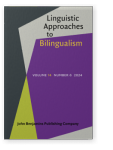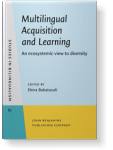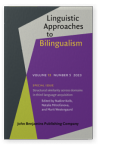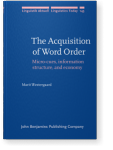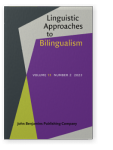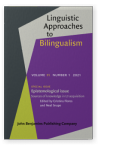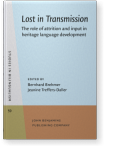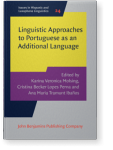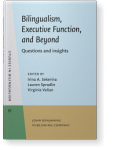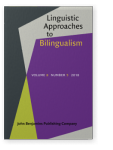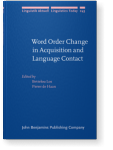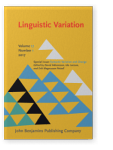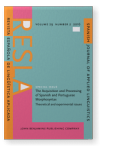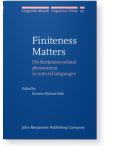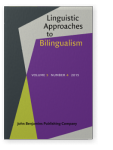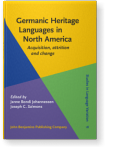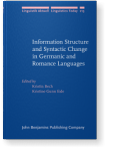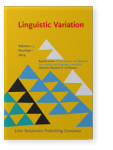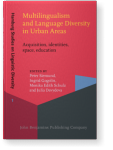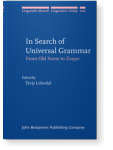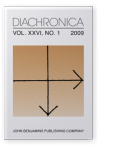Marit Westergaard
List of John Benjamins publications for which Marit Westergaard plays a role.
Journal
Book series
Titles
Structural similarity across domains in third language acquisition
Edited by Nadine Kolb, Natalia Mitrofanova and Marit Westergaard
Special issue of Linguistic Approaches to Bilingualism 13:5 (2023) v, 136 pp.
Subjects Cognition and language | Cognitive psychology | Language acquisition | Multilingualism | Psycholinguistics | Theoretical linguistics
The Acquisition of Word Order: Micro-cues, information structure, and economy
Marit Westergaard
[Linguistik Aktuell/Linguistics Today, 145] 2009. xii, 245 pp.
Subjects Generative linguistics | Germanic linguistics | Language acquisition | Syntax | Theoretical linguistics
2023 Structural similarity in third language acquisition: Linguistic approaches to bilingualism Structural similarity across domains in third language acquisition, Kolb, Nadine, Natalia Mitrofanova and Marit Westergaard (eds.), pp. 607–613 | Review article
2023 Crosslinguistic influence in L3 acquisition: Evidence from artificial language learning Structural similarity across domains in third language acquisition, Kolb, Nadine, Natalia Mitrofanova and Marit Westergaard (eds.), pp. 717–742 | Article
This study investigates the role of lexical vs structural similarity in L3 acquisition. We designed a mini-artificial language learning task where the novel L3 was lexically based on Norwegian but included a property that was present in Russian and Greek yet absent in Norwegian (grammatical… read more
2023 Variable V2 in Norwegian heritage language: An effect of crosslinguistic influence? Linguistic Approaches to Bilingualism 13:2, pp. 133–162 | Article
This paper discusses possible attrition of verb second (V2) word order in Norwegian heritage language by investigating a corpus of spontaneous speech produced by 50 2nd–4th generation heritage speakers in North America. The study confirms previous findings that V2 word order is generally stable… read more
2021 The plausibility of wholesale vs. property-by-property transfer in L 3 acquisition Epistemological issue: Sources of knowledge in L3 acquisition, Flores, Cristina and Neal Snape (eds.), pp. 103–108 | Commentary
2020 Word order variation in heritage languages: Subject shift and object shift in Norwegian Lost in Transmission: The role of attrition and input in heritage language development, Brehmer, Bernhard and Jeanine Treffers-Daller (eds.), pp. 99–124 | Chapter
This study investigates two word order phenomena in Norwegian heritage language spoken in the US, subject shift (SS) and object shift (OS). SS and OS occur in syntactic environments where (pronominal) subjects and objects may either precede or follow negation. This paper explores to what extent… read more
2020 Syntactic contrasts in early and late Brazilian Portuguese-European Portuguese bidialectal bilinguals: Data from production Linguistic Approaches to Portuguese as an Additional Language, Molsing, Karina Veronica, Cristina Becker Lopes Perna and Ana Maria Tramunt Ibaños (eds.), pp. 35–59 | Chapter
This study explores the production of subject and object pronouns in the case of Brazilian Portuguese (BP) and European Portuguese (EP) early and late bidialectal bilinguals. The distribution of empty categories in the two systems differs in terms of syntactic and semantic constraints. In this… read more
2019 Chapter 10. Language control and executive control: Can studies on language processing distinguish the two? Bilingualism, Executive Function, and Beyond: Questions and insights, Sekerina, Irina A., Lauren Spradlin and Virginia Valian (eds.), pp. 147–160 | Chapter
In this paper, we review recent literature on the cognitive benefits of bilingualism and suggest that studies focusing on language processing can provide insights in the debate surrounding the “bilingual advantage hypothesis”. We argue that cross-language priming can be a useful research tool,… read more
2018 Exploring the role of cognitive control in syntactic processing: Evidence from cross-language priming in bilingual children Linguistic Approaches to Bilingualism 8:5, pp. 606–636 | Article
In this paper, we explore the role of cognition in bilingual syntactic processing by employing a structural priming paradigm. A group of Norwegian-English bilingual children and an age-matched group of Norwegian monolingual children were tested in a priming task that included both a… read more
2017 Chapter 3. Word order and verb movement in Norwegian wh-questions: A comparison of production and judgment data Word Order Change in Acquisition and Language Contact: Essays in honour of Ans van Kemenade, Los, Bettelou and Pieter de Haan (eds.), pp. 35–56 | Chapter
This paper compares production and judgment data collected from several North Norwegian dialects, focusing on word order variation in wh-questions (V2 vs. non-V2). The findings show that non-V2 is widespread in questions with monosyllabic wh-elements and also fully accepted in questions with… read more
2017 Variation and change in Norwegian wh -questions: The role of the complementizer som Syntactic Variation and Change, Håkansson, David, Ida Larsson and Erik Magnusson Petzell (eds.), pp. 8–43 | Article
In this paper, we consider variation in Verb Second (V2) word order in wh-questions across Norwegian dialects by investigating data from the Nordic Syntax Database (NSD), which consists of acceptability judgments collected at more than 100 locations in Norway. We trace the geographical… read more
2016 Comparing anaphora resolution in early and late Brazilian Portuguese-European Portuguese bidialectal bilinguals The Acquisition and Processing of Spanish and Portuguese Morphosyntax: Theoretical and experimental issues, Klassen, Rachel, Anahí Alba de la Fuente, Joanne Markle LaMontagne and Almudena Basanta y Romero-Valdespino (eds.), pp. 429–461 | Article
The present study examines anaphora resolution in two groups of speakers exposed to Brazilian and European Portuguese (BP and EP, respectively), considering the different null subject distribution in these languages. Our research question is whether late BP-EP bilinguals (age of EP onset: 29.1)… read more
2016 Word order and finiteness in acquisition: A study of Norwegian and English Wh-questions Finiteness Matters: On finiteness-related phenomena in natural languages, Eide, Kristin Melum (ed.), pp. 257–286 | Article
Children acquiring languages such as English, German or Dutch typically go through a phase where they produce non-finite root clauses, often referred to as the Optional Infinitive (OI) stage. But there is a difference between English on the one hand and the other Germanic languages on the other… read more
2015 Word Order Variation in Norwegian Possessive Constructions: Bilingual Acquisition and Attrition Germanic Heritage Languages in North America: Acquisition, attrition and change, Johannessen, Janne Bondi † and Joseph C. Salmons (eds.), pp. 21–45 | Article
In Norwegian possessive constructions, the possessive may either precede or follow the noun. Monolingual children initially show a preference for the prenominal possessive construction, although it is much less frequent than the postnominal one in the adult language. A likely explanation is that… read more
2014 Word order variation in late Middle English: The effect of information structure and audience design Information Structure and Syntactic Change in Germanic and Romance Languages, Bech, Kristin and Kristine Gunn Eide (eds.), pp. 203–232 | Article
This paper discusses the considerable word order variation that existed at the end of the Middle English period, by studying four prose texts written by the same author, John Capgrave. The data are investigated in terms of information structure, and we identify the effect of three different… read more
2014 Linguistic variation and micro-cues in first language acquisition Three Factors and Beyond: Socio-syntax and language acquisition, Grohmann, Kleanthes K. (ed.), pp. 26–45 | Article
Children are often exposed to considerable variation in the input. Nevertheless, there is very little overgeneralization in child language data and children are typically found to make errors of omission, not errors of commission, a fact which is often referred to as conservative learning. In this… read more
2013 Two gender systems in one mind: The acquisition of grammatical gender in Norwegian-Russian bilinguals Multilingualism and Language Diversity in Urban Areas: Acquisition, identities, space, education, Siemund, Peter, Ingrid Gogolin, Monika Edith Schulz and Julia Davydova (eds.), pp. 95–126 | Article
This study investigates the simultaneous acquisition of two different grammatical gender systems by Norwegian-Russian children. The main difference between the two languages is transparency of gender assignment: Gender is relatively predictable in Russian, while it is more or less idiosyncratic in… read more
2013 The acquisition of linguistic variation: Parameters vs. micro-cues In Search of Universal Grammar: From Old Norse to Zoque, Lohndal, Terje (ed.), pp. 275–298 | Article
Against the backdrop of some traditional generative work on parameters as well as some recent constructivist work, this paper discusses how children handle variation that they are exposed to in the input. Investigating different types of word order variation, the paper finds no evidence for… read more
2009 Word Order in Old and Middle English: The role of information structure and first language acquisition Diachronica 26:1, pp. 65–102 | Article
In the history of English one finds a mixture of V2 and non-V2 word order in declaratives for several hundred years, with frequencies suggesting a relatively gradual development in the direction of non-V2. Within an extended version of a cue-based approach to acquisition and change, this paper… read more
2008 3. Verb movement and subject placement in the acquisition of word order: Pragmatics or structural economy? First Language Acquisition of Morphology and Syntax: Perspectives across languages and learners, Guijarro-Fuentes, Pedro, María Pilar Larrañaga and John Clibbens (eds.), pp. 61–86 | Article
This chapter reports on a study investigating three children acquiring a dialect of Norwegian (Tromsø). It is shown that, although verb-second (V2) word order is attested early in non-subject-initial declaratives and questions, the children produce non-target-consistent word order in these… read more
2003 Unlearning V2: Transfer, markedness, and the importance of input cues in the acquisition of word order in English by Norwegian children EUROSLA Yearbook: Volume 3 (2003), Foster-Cohen, Susan H. and Simona Pekarek Doehler (eds.), pp. 77–101 | Article
This study investigates how child speakers of a verb second (V2) language acquire the supposedly more basic SVO word order of English. Data comes from approximately 100 Norwegian school children aged 7 to 12 in their acquisition of three related syntactic constructions. The focus of the… read more
